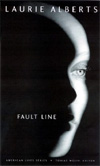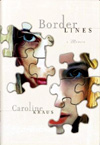




 |
 |
Psycho Babble
Alternative memoirs examine frayed human conditions
by Jonathan B. Frey
The penultimate words of Caroline Kraus’ memoir, Borderlines (Broadway, $24), contain an odd directive: “Keep moving. Because the human mind is tricky. And we ought not to linger in its dark places.” Paradoxically, the previous 350 pages serve precisely that purpose: to linger on the dark psychological resumes of herself and several others, a veritable diary of borderline personality disorder (BPD) and its malcontents. Similar lingering occupies Laurie Alberts’ Fault Line (Nebraska, $22), published within weeks of Kraus’ volume, another chronicle of disturbed psyche and the consequences thereof. Together, Borderlines and Fault Line are as end tables to the psychiatrist’s proverbial couch, opposing perspectives of the same DSM-IV cataloged disorder.
Both books concern women of intelligence, beauty and privilege who’ve experienced troubled maternal relationships and unconfirmed child abuse, and who develop into promiscuous and manipulative sufferers of BPD. Moreover, both books feature victims of their  manipulation, those who’ve fallen prey to their beauty and charm and suffer as a result. However, that is where the similarities end, for Kraus is the victim of her account, whereas Alberts isn’t of hers. Reading between the lines of each narrative, they could be writing figuratively about each other. manipulation, those who’ve fallen prey to their beauty and charm and suffer as a result. However, that is where the similarities end, for Kraus is the victim of her account, whereas Alberts isn’t of hers. Reading between the lines of each narrative, they could be writing figuratively about each other.
Borderlines is set in the early ‘90s, when Kraus moves to San Francisco following her college graduation and the death of her mother from cancer. While working in a Palo Alto bookstore, Kraus meets and befriends Jane Lowell, a disturbed and damaged yet highly charming woman of like age to whom Kraus becomes attached. They become close, share an apartment, and are increasingly inseparable, mutually dependent. In due course, ostensibly in service of sustaining an unsustainable relationship, Kraus will ultimately surrender her inheritance, sexual preference, ambitions, self-respect and moral sense. Along the way, both women’s background and family are introduced, elements that combine with the emotional rollercoaster that is Kraus and Lowell’s relationship to appall and fascinate the reader, ringside witness to an unimaginably destructive intimacy.
Destruction of a more profound kind results in Fault Line, which begins in the late ‘60s and extends to 1996, the year in which Kim Janik is found dead from exposure in Colorado. Alberts had become acquainted with Janik in 1969, while Janik was a junior at Harvard and Alberts was a junior in high school. In this account, Alberts, our narrator, plays the charming manipulator role, to which Janik is arguably never able to recover, focal point of Alberts’  passion and subsequent defections. During the early ‘70s, Alberts and Janik hitchhike across the US, during which her betrayal of affections starts as shocking at first but proceeds predictably. Nevertheless, probable quarry to his own psychic ills as well, Janik continues obsessed with Alberts for nearly three decades before giving himself over to drink, the effects of which indirectly cause his death. Janik, unlike Kraus in Borderlines, cannot defeat his attachment, and succumbs. passion and subsequent defections. During the early ‘70s, Alberts and Janik hitchhike across the US, during which her betrayal of affections starts as shocking at first but proceeds predictably. Nevertheless, probable quarry to his own psychic ills as well, Janik continues obsessed with Alberts for nearly three decades before giving himself over to drink, the effects of which indirectly cause his death. Janik, unlike Kraus in Borderlines, cannot defeat his attachment, and succumbs.
What is to be made of these memoirs? Kraus desires “in [her] depictions, introspections, and experiences, to make sense of what happened to [her]; to yield larger meaning to [her] experience; and, in so doing, to transform devastating and difficult events into the most hopeful of outcomes, which is wisdom.” Alberts, on the other hand, means “to find the truth” behind Janik’s death and to determine her role in it, if any: “How can I know if I was at the center of Kim’s destruction? But if I don’t tell this tale, with all my biases there is no one else who will.” However, neither examine with any urgency the nature of the illness that plays a central role in the tragedies they describe, nor do they ever make clear what the characteristics of BPD are, examine its causes, its controversies. These details are left to the reader to discover as independent study of the Diagnostic and Statistical Manual of Mental Disorders (fourth ed.). It’s as if a historian chose to record the contemporary history of South Africa without directly addressing or defining the meaning of apartheid. People are described, their feelings shared in disturbingly fine granularity, and consequences closely detailed, but conclusions are difficult to draw.
Deprived of conclusions, we are left only with the particulars of each case. Indeed, these narratives owe much to their intimate specifics, especially the degree to which their intimacies engage the reader, residing as intimate specifics tend to in that gray spectrum extending from banality to prurience. As such, these accounts risk being mistaken less for memoir or substantive prose of any genre and instead for literary psychotherapy, belletristic exorcism, and/or high-brow Jerry Springer for the over-educated.

August 19, 2004 • Vol. 14, No. 34
© 2004 Metro Pulse
|
|